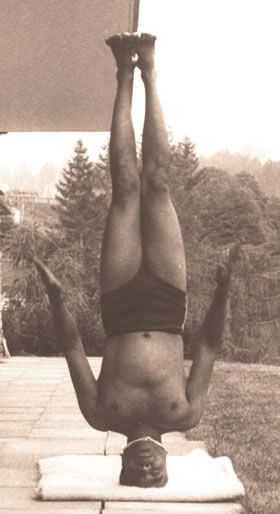Upside-down, Yoga Turns Me

Yes, please know that this is the song I have in my head right now…https://www.youtube.com/watch?v=GIAtE6ywgwA…
Yoga does turn us upside-down and inside out and also round and round…and so it is helpful once again to understand some of the common Sanskrit terminology that appears to give us these directions and descriptions.
“Inverted” is more the translation within Sanskrit than “Upside-down”. The term Viparita shows up in one favorite and one maybe one not-so-favorite poses. Viparita Karani (literally translated as “the act of inverting”) is our all purpose legs-up-the-wall pose done with and without props depending on the purpose and the day. Dwi Pada Viparita Dandasana (two footed inverted staff pose) is an intense backbend more typically done in the chair until well practiced.
Upward (Urdhva) and downward (Adho) show up a lot in the direction. Urdhva Mukha and Adho Mukha Svanasanas (up facing and down facing dogs) are common. Urdhva also is seen in regards to feet and hands as well : Urdhva Hastasana (upward hands) and Urdhva Prasarita Padasana (upward extending feet).
A twist typically has “Parivrtta” in the name and a pose going to or acting mostly on one side or another is “Parsva”. Parivrtta Trikonasana (triangle pose twisted) and Parivrtta Parsvakonasana (side angle pose twisted) are common twisted standing poses. Parsva Uttanasana (that becomes Parsvottanasana put together…we will cover this soon) or Parsvakonasana (side angle pose) are familiar poses that stretch one side intensely.
Then there is everyone’s favorite, SUPTA!!! When one hears “Supta” anything, you know that it is more restorative and done lying down. But don’t let that fool you for long, it can also mean “sleeping” or “resting” and if it is Supta Kurmasana (the sleeping turtle…see photo in Light on Yoga), you might wonder about how sleepy you might be within that pose.
Yoga also brings us a lot of stretching and extension and in all sorts of directions, so Prasarita (extended and or wide) and Utthita (extended) are used in numerous positions. Urdhva Prasarita Padasana (upward extending feet) and Prasarita Padottanasana (feet wide forward extension) are ones we do a lot in classes, and Utthita comes before most standing pose names, though we tend to eliminate it in shorthand when teaching (Utthita Trikonasana and Utthita Parsvakonasana are the full names of those poses).
East and West are directions, but also “faces” of the body. Paschima Uttanasana (Paschimottanasana when put all together) is the intense stretch of the back side (or west side) of the body. Purvo Uttanasana (Purvottanasana) is the intense stretch of the front side (or east side) of the body.
There are half (Ardha) poses and full (paripurna) poses to make sure we all have stages and levels to do. Some common ones here are Ardha and Paripurna Navasanas (boat poses), Ardha Matsyendrasana (seated twist) and Ardha Chandrasana (half moon).
Baddha is bound. We hear this in Supta Baddha Konasana (lying down bound angle position) and Ardha Baddha Padma positions when grasping one foot in padmasana (lotus) both sitting and standing. Another common form is Baddha Hastasana which is the grasping of the elbows over head and behind the back or Baddhanguliasana (interlacing and binding all the fingers).
There are of course a few more, but you can come to see the bulletin board to get all those details. The descriptors and directions are important in understanding the actions of any pose, so learning this piece of Sanskrit can go a long way!! They repeat themselves often and are used in most names describing where all the body parts all go.